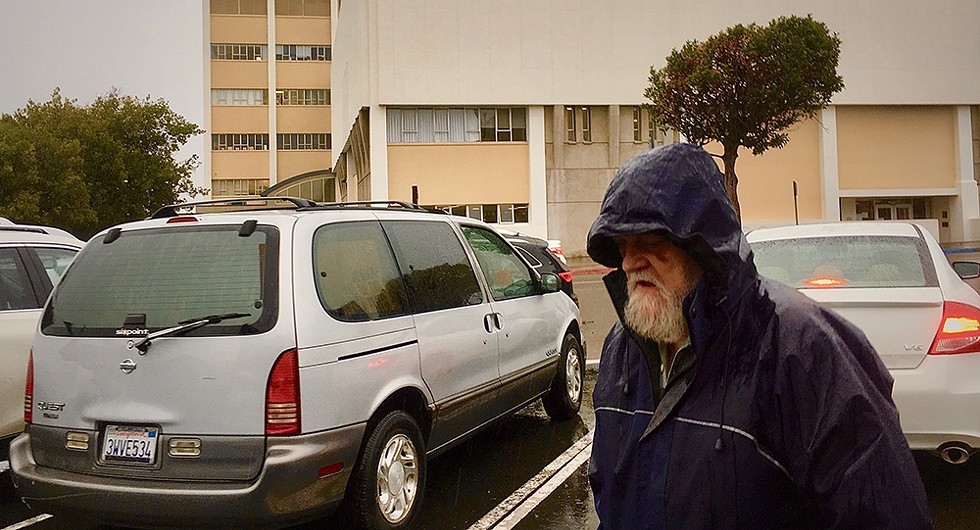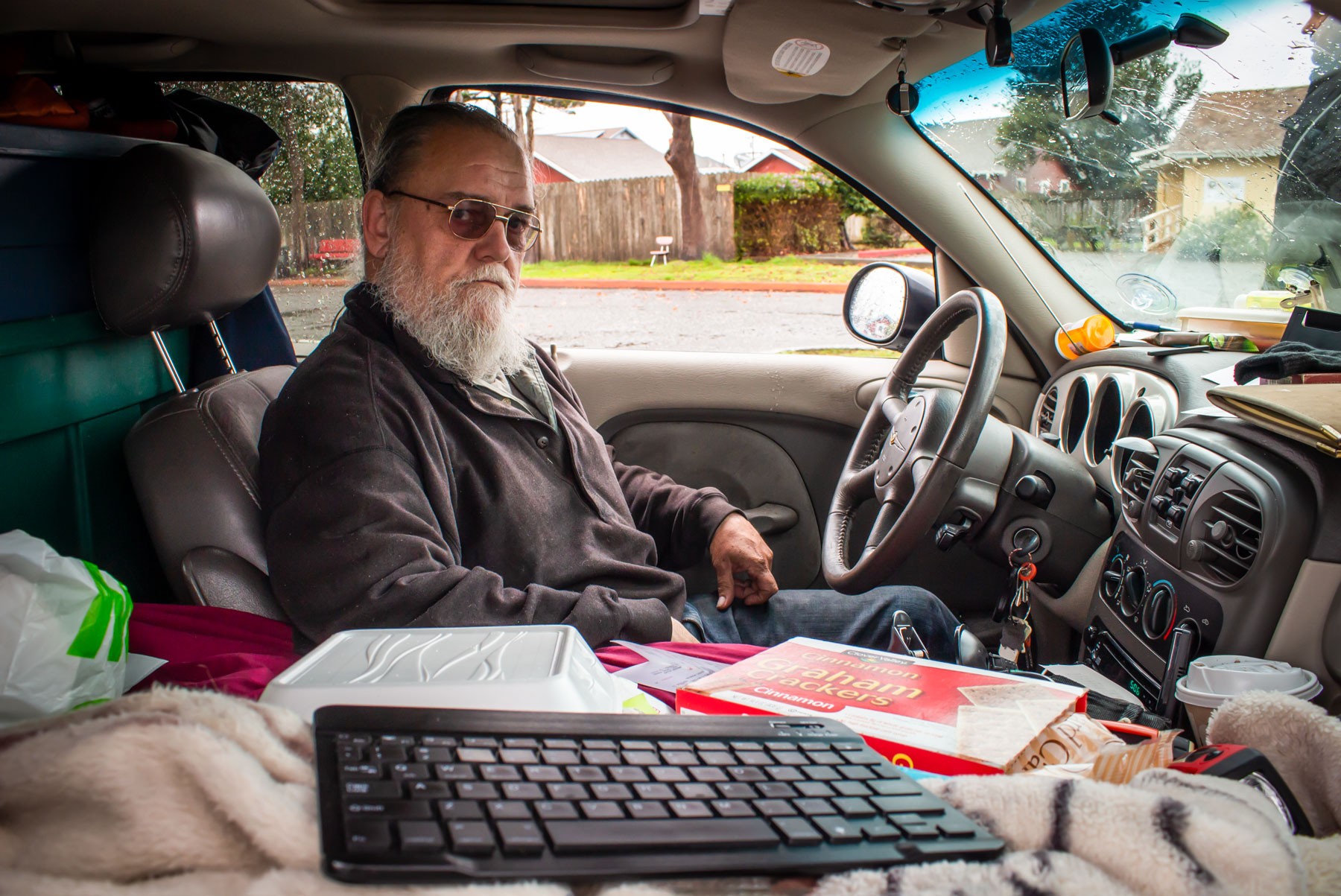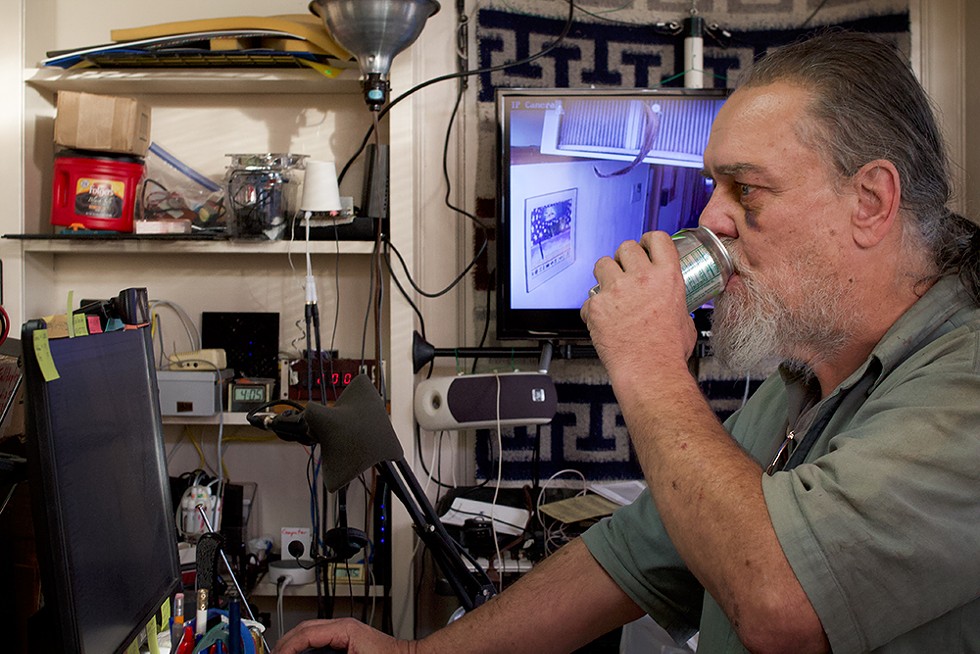Digital Nomad: A Bipolar Man's Slow Slide into Homelessness in Humboldt
By Freddy Brewster and T.William Wallin[
{
"name": "Top Stories Video Pair",
"insertPoint": "15",
"component": "17087298",
"parentWrapperClass": "fdn-ads-inline-content-block",
"requiredCountToDisplay": "1"
}
]
With his head hung low and a purple, black eye cast to the ground, Robert Stretton crossed the street outside the Humboldt County Courthouse on the cold, rainy afternoon of Dec. 20. He had just been served with a restraining order, a day after being evicted from an office on Eureka's E Street that he'd lived in since Oct. 1. As he crossed the street, he contemplated his next moves. One possibility was to travel to Big Lagoon to find a friend named Dude Whiting and camp with him for the night. The other was to pack up his belongings before the doors were locked at his office.
With just five days before Christmas, Stretton, like hundreds of others in Humboldt County, would be homeless for the holiday.
"Right now is the lowest point in my life," the 64 year old said that afternoon. "I'm scared to death with what my future holds."
Stretton's path to Humboldt County and his current plight is a windy one, filled with many ups and downs that mirror his mental state. Diagnosed with bipolar 1 disorder in 1999, Stretton's life has known little stability in any sense. He has four ex-wives, an equal number of restraining orders and three children, all of whom refuse to talk to him.
According to Mental Health America, 4.4 percent of the U.S. population has been diagnosed with bipolar 1 disorder and people with mental illness are more likely to find themselves on the streets. Around one-third of the entire homeless population suffers from a mental illness, according to Treatment Advocacy Center. The 2018 Annual Homeless Assessment Report found that about 130,000 people are homeless in California on any given night, an average of 33 per every 10,000 state residents. The Humboldt Housing and Homeless Coalition conducted a point in time survey in January and found 1,470 unsheltered people, making Humboldt County's homeless rate more than three times that of California and six times that of the nation.
Bipolar disorder is not a mental illness that commonly manifests in a way that evokes compassion. Instead, it often presents in socially unacceptable behavior that can simply make someone seem like an asshole.
In Stretton's case, the illness causes him to bring problems upon himself but he's also lived with it so long that it's an ingrained part of his personality and his sense of self. One cannot separate the mental illness from the man. If you strip it away, Stretton is not sure what would be left. He describes the illness as like being on a rollercoaster that moves through dark tunnels with no end in sight.
"As I look back on my life, I realize that many problems were due to being bipolar," Stretton said. "My bipolar mental issues come from both sides of the family, back then they didn't know what bipolar was."
Stretton was born in Vancouver, British Columbia, on March 3, 1955, to Joseph and Eva Stretton. His father left the picture when Stretton was young and his mother moved the family to Washington and then Oregon briefly before landing in Ohio. Stretton said he and his sister were placed in foster care there for short periods of time due to his mother's mental illness, which she coped with by sometimes running away with different men.
Stretton attended high school in Centerville, Ohio, in the early 1970s. He was a tinkerer and, afraid of chemicals but always fascinated with electricity, would build light shows for friends. Constantly bullied and harassed because of his dyslexia and promiscuous mother, Stretton said he stuck to working on gadgets and electrical projects, never engaging much with his peers.
Alan Starrat, Stretton's cousin, is the only family member Stretton has regular contact with and the only one who agreed to speak with the Journal for this story. A violist in a New Zealand-based orchestra, Starrat often chats with Stretton over Facebook and visited him in December, giving Stretton a dose of optimism during the holidays. Starrat rented a car and joined Stretton on the streets of Eureka for a few nights and the two also camped in Big Lagoon with Whiting, Stretton's friend. Starrat said mental illness and depression run in Stretton's family, most prominently on his mother's side.
"He was an electronics whiz from an early age," Starrat said. "His mom was more into the high life and gave the kids things rather than attention."
Timothy Gannon, the medical director for Humboldt County Mental Health, said that people who have blood relatives with bipolar disorder are 10 times more likely than the general population to have the illness. Symptoms tend to manifest around the age of 18, Ganon said, which is when Stretton met his first wife, while still in high school.
Her name was Patty Larrick and Stretton said he used his charm and a 1965 Chevrolet Malibu to woo her. Larrick and Stretton dated for four years before getting married but it would prove short-lived, lasting only another four years.
"It took me over 40 years to get over her," Stretton said. "I've been wanting to apologize to her all my life about anything in general if I caused her harm. I've been looking for answers of why she kicked me out."
Not long after the divorce, Stretton moved to Gilroy, California. The move immersed him in the beginning of the first Silicon Valley tech boom, back when it was all HAM radios and Commodore 64s. Electricity was in high demand in the valley and Stretton was there to provide it, believing he'd found his place and calling as an electrician. Around the same time, he met his second wife, Tona Blanchard.
"Tona and I hit it off," Stretton said. "For a year and a half in Silicon Valley, electrical work was top dollar. I was swimming in cash."
The marriage with Blanchard was short-lived but Melissa, Stretton's first daughter, was born in March of 1981. The entire relationship lasted only a year and a half before Blanchard and the newborn headed back east.
A common barrier families face with mental illness is keeping problems bottled. Lea Nagy, vice president of the National Alliance of Mental Illness of Humboldt, said that because of stigma and discrimination toward those suffering with a mental illness, families don't talk about their struggles and they often don't get help.
"There used to be a bipolar support group in Humboldt County and that's what's needed," Nagy said. "Support groups provide information and hope for people. They help families not to give up too soon."
Stretton had his second child with his third wife, Jami Finch. The two met while working an electrical job in Santa Clara and their marriage was a "business relationship," he said, in which Finch was going to be the bookkeeper and Stretton would do the manual work. But drugs and Stretton's illness got in the way.
"I had coke problems for a while, alcohol for a while," Stretton said. "But I never needed rehab. I was always able to break away."
Drugs and alcohol can have a detrimental effect on those with bipolar, though a national survey by the American Journal of Managed Care found that more than 55 percent of individuals with bipolar disorder have experienced addiction at some point in their lives. According to the Recovery Village, an alcohol, addiction and drug rehabilitation center, cocaine use with bipolar disorder can intensify symptoms and make decision-making difficult. Gannon also said drug and alcohol use can interfere with treatment plans.
"If they start drinking or doing drugs, then it decreases the chance that they are going to take their bipolar meds," Gannon said. "Which could enhance the likelihood of another episode occurring."
In 1985, Stretton met his fourth and final wife. Music pumped through the speakers as drinks were poured that night in Sunnyvale's Odyssey Room. Sandy Adams was on stage and Stretton looked on with his big blue eyes. Adams and Stretton would spend the next 11 years together, making this Stretton's longest relationship.
"She was a tall blonde singing with a band," Stretton said. "She liked to sing."
While the two never officially wed, Stretton claims they had a common-law marriage, even though California did away with such arrangements in 1895. Regardless, Stretton calls Adams his "ex" and the two had a child together. Brittany Stretton was born on Jan. 9, 1990, the youngest of Stretton's children and the only one to live with him as a teenager.
Stretton and Adams split in 1995, shortly after Stretton's mother died. After the separation, Stretton headed to Gilroy but the heat started to wear on him. He was collecting Supplemental Security Income for a knee disability and wanted to move somewhere new.
In the early 1990s Stretton reconnected with his father, who was living in Humboldt County. After nearly 30 years of being estranged, Stretton and his father, Joseph, reconnected via the HAM radio network. (HAM radios are essentially walkie-talkies with signals that reach around the globe.) A friend of Stretton's was a HAM radio guru and compiled a database of all HAM radio operators. One day, Stretton was curious and looked up his name. Lo and behold, he found another Stretton — his father.
"Every HAM radio operator uses certain frequencies to follow each other," Stretton said. "HAM radio hooked us up, again."
Stretton's father secured him a place for three months in Fortuna in 2000. They had a falling out almost immediately.
"My father and I didn't see eye to eye," Stretton said. "'Sink or swim,' he told me."
Stretton moved to Eureka shorty after his stint in Fortuna. Troubles with landlords and other tenants kept him jumping from place to place for the next few years. He finally found sanctuary for about 12 years with J & J Rentals through Section 8 housing.
Once in Humboldt County, Stretton was finally diagnosed with what he had been struggling with his entire life, bipolar 1 disorder. The acknowledgment seemed too late to mitigate the damage that Stretton had trudged through since adolescence, but he hoped it would bring positive change to his life moving forward.
"I obviously had issues, but couldn't explain them since I hadn't been diagnosed," Stretton said. "What people don't understand is I don't think like other people. My first reaction is emotional and not logical."
Stretton said he has no warning when his moods change, causing sudden outbursts that have continuously caused problems with his neighbors and brought instability to his living situations. When he began renting from the Paye family, who own J & J Rentals, his youngest child, Brittany, moved in with him when she was 15. But this also would prove short lived. After an argument with Brittany over dinner, Stretton snapped.
"I broke the door off the hinges," Stretton said. "I scared her by screaming and yelling. It would appear I bring it upon myself but I have no control. I just can't seem to find peace. She hates me because of one of my bipolar episodes."
Gannon has more than 18 years of experience working in the mental health field and said the signs and symptoms of bipolar 1 disorder vary from inflated self-esteem, racing thoughts and high energy to antisocial behavior, delusions of grandeur and sometimes dangerous outbursts.
"For a bipolar person, their behavior has to be abnormal," Gannon said. "And those behaviors should be persistent across time. The mood you're looking for is elevated, expansive or irritable. All of these things should be marked as different from their normal behaviors."
Nagy, of NAMI of Humboldt, said having the support of a friend or family member is a crucial factor in the well-being of those suffering with a mental illness. There are times when they have problems functioning and can become confused or psychotic, she said, and just having someone around can make a huge difference.
"Bipolar disorder is a hidden illness," Nagy said "There is a lot of discrimination and society thinks they should just pull themselves up by the bootstraps, but that isn't the case."
For those who struggle with bipolar disorder, even small things can trigger an outburst — which for Stretton has resulted in multiple restraining orders. The first came after he and a neighbor, Kathryn Fitzgerald, got into a fight Sept. 26, 2014. It started verbally but escalated with Fitzgerald striking Stretton in the mouth and then Stretton retaliating, pushing Fitzgerald down against a set of stairs and grabbing her throat. Stretton was charged with misdemeanor assault and battery but the case was dismissed four years later.
Tim Ash, chair of Humboldt County Behavioral Board, said U.S. jail and prison populations have skyrocketed because of the closing of mental health facilities, pointing to a study by the Treatment Advocacy Center that found the United States has "eliminated more than 96 percent of the last-resort beds that existed in the mid-1950s." The center's study went on to say that there is common knowledge of a need for more psychiatric beds but "neither the United States nor its individual states have conducted research to establish evidence-based bed supply ranges."
"If (the mentally ill) had an option to go somewhere, they would, but we don't have that option in this community," Ash said. "What we really need is a continuum of services that suits the individuals with mental disabilities because everyone is different."
Ash went on to say there are not enough psychiatrists or services for the mentally ill in Humboldt County and this lack of help is why people with bipolar end up in the criminal justice system "more than we would like to admit."
Stretton's next three restraining orders came four years after the altercation with Fitzgerald, filed within months of each other. On June 6, 2018, Elaina Robinson, a neighbor, filed one over disputes at their apartment complex. According to documents obtained from a public records request, Robinson alleged that Stretton would feed her cat "human food like tacos with sour cream and ... even a full loaf of moldy bread." Multiple arguments ensued and one ended with a shouting match on Robinson's front porch.
"He came up to my porch, less than 6 inches away from my face, and balled up his fist as if to hit me," Robinson reported.
Stretton would go on to intimidate and challenge his neighbors to fights and leave notes on their cars and doors. One of the last incidents documented in the filing involved Stretton spraying Robinson in the face with a hose.
"The only reason I got that apartment was because I made friends with the Section 8 housing inspector," Stretton said. "He pulled some strings to get me in there. Once I got evicted, I knew there was nobody that was going to rent to me with my record."
This is a reason why Stretton believes he needs a liaison who could help him find and maintain housing, navigate the mental health system and access services.
"I need somebody that can stand beside me," Stretton said. "That can help me along the way with the things I need to do. To go to appointments, fill out paperwork and point me in the right direction. This should be a thing that is available to everybody with a mental illness. Everybody is different, people are not statistics and you cannot take care of people based on statistics."
Tim Ash agrees and said that a possible solution for those with mental illness would be a supportive housing project.
"What we need is Crisis Residential, which is like an apartment complex where people live in studios," Ash said. "The barriers to get in wouldn't be difficult and someone would help them with case managing and getting them to appointments — somebody watching out for them."
One of the barriers that has historically stood in the way of these types of solutions is the Medicaid Institution for Mental Diseases Exclusion, which went into effect in 1965 and essentially prohibited Medicaid from financing large-scale residential treatment facilities. The U.S. Department of Health and Human Services has recently given states the option of applying for waivers but only if they can prove they have maintained "robust" community-based treatment programs.
"The IMD Exclusion was essentially written to not warehouse the mentally ill," Ash said. "The government said that we want [the mentally ill] in the community but the communities never got reimbursements for services."
Stretton's living space in his office on the fifth floor of the E Street building in Eureka reflected his love for all things electrical. Entering into the 200-square-foot room was like walking into a circuit breaker. An "S" shaped path marked with wires, empty soda cans, a makeshift stove and electronics wove throughout the space. The room was divided by a standing desk covered with receipts, radio equipment and a variety of gadgets. A computer stand sat littered with multi-colored post-it notes covered in phone numbers of friends and family, and reminders.
A monitor hung to the side of the desk, displaying security camera footage from the hallway outside. Stretton ran a pirate radio station, 89.7 FM, that pumped out EDM music and announced his moniker, a voice recording saying, "The Original Yuppie Bastard," every 30 minutes to mark the time. Hanging from the ceiling, and shielding his bed — which was supported by used soda syrup containers — were makeshift window blinds attached directly to the ceiling. Next to the blinds, a self-rigged electrical connection hung from a fluorescent light fixture, powering Stretton's tangled web of electronics. A drum machine sat near his bed.
"The drum pad allows me to focus when I get angry, to keep a beat," Stretton said. "I have to focus 110 percent so it helps me deal with pain and memory. I've been spending my days on the computer studying Google patent searches and semiconductor data sheets. I want to be left alone to work on my inventions. I'll shit in a bucket, I'm not proud."
Stretton's Dec. 20 court date laid out a stark contrast between plaintiff and defendant. Linda Disiere, Stretton's landlord at the E Street office, wore a brown sweater with horned rim glasses, short blonde hair and gold earrings. Stretton wore his hair back in a ragged ponytail, his clothes were stained and worn and he had a black eye from a fight he got into in a McDonald's parking lot the week before.
"My living in my office is only a temporary thing," Stretton told to the court.
During his stay in the office, Stretton had sent emails to all tenants of the building, often with ambiguous warnings, like, "It looks like Plan 'B' is my new course of action, if this cannot be resolved peacefully."
"There were many emails sent with how he would seek revenge," Disiere said. "I am afraid to walk out of the door because I don't know what he will do."
According to emails that Disiere submitted in the restraining order request, Stretton aluded to threats of violence that would be "unleashed explosively when the time comes."
Humboldt County Superior Court Judge Kelly Neel, who also heard Stretton's other 2018 case, acknowledged his mental illness, as well as his current housing situation, before casting her decision. She ordered him not to communicate with Disiere in any way and to stay at least 25 yards away from her for the next year. His items in the office would be moved at the expense of Disiere but stored at Stretton's. With no plan for his future, Stretton stared ahead, seemingly bewildered by his impending homelessness.
"Best of luck to everyone," Neel said as she finished that day's hearing.
"After court, suicide entered the picture once again," Stretton said. "I struggle with that from day to day but I have to keep chugging along."
Suicide is 15 times more common among those with bipolar disorder, according to Gannon.
"When they look at suicides they tend to think that bipolar can account for 25 percent of them," Gannon said. "That's a huge amount."
The morning of Dec. 22, 2018, Robert Stretton awoke in an empty parking lot in Big Lagoon. After being evicted from his E Street office, he had headed north to meet up with Whiting.
The two met through a mutual friend, Tom Sebourn, a few years back and Stretton built a website for Whiting and his philosophical approach to life ("dudeolosophy").
"I have a lot of knowledge of living on the road," Whiting said. "I think Robert is a lot like other human beings, struggling with finding their place in the world."
Stretton is savvy in the old ways of the internet. He has built more than 60 websites, but all lack current graphics and interactivity that have become commonplace. But for Stretton, they are part of a way of life and a means by which he finds value for himself.
One of Stretton's websites is dedicated to an invention he hopes will help him bust out of his current situation. It is called "Starling Navigation" and is a "paradigm traffic controller" based on "new-found knowledge" of "bird navigation techniques" that he believes will save millions of lives. Stretton said his inventing career has been hampered by a lack of support.
"Genius is a three-legged stool," Stretton said. "You have the knack for it, you were born with it and you have support to back it. I have the first two but no one to back me."
Gannon said most people with bipolar disorder will get better with treatment and that, as they age, their episodes tend to switch from manic to depressive. But he said about 30 percent of those diagnosed remain severely impaired and "can't get back to normal."
Lacking stability, Stretton seems to fall into that 30 percent. He also can't seem to stay out of trouble. On Feb. 27, Kathleen Ward, an ex-girlfriend of one of Stretton's friends, filed a restraining order against him, alleging he'd sent her threatening messages via Facebook. Asked about them, Stretton was unapologetic.
"You get me going or riled up and I'll say anything to get you to back off," he said. "I don't mean any of that stuff, it just comes out. I may threaten someone but I would never hurt them."
Stretton's future is unknown but he said he wants to make it to Vandenburg Air Force Base in Lompoc to watch a rocket launch "before it's all over." He is currently spending his nights in a PT Cruiser in the parking lot of a local mental health facility, a self-described "digital nomad" with his HAM radio at his side and five prescription pill bottles in the passenger seat, a new addition to the homeless of Humboldt.
Freddy Brewster is a junior at Humboldt State University majoring in journalism and working as a freelance reporter. T.William Wallin is a junior at Humboldt State University majoring in journalism and minoring in east religious studies. He also works as a freelance reporter.
Speaking of...
Comments (4)
Showing 1-4 of 4
More by Freddy Brewster
-
With Housing Element Passed, Staff Pushes Forward on Tiny Houses
- Aug 29, 2019
-
'Outside the Box'
Planning Commission moves draft housing element to Supes
- Jul 18, 2019
-
Draft Housing Element Calls for Drastic Solutions to Humboldt's Housing 'Crisis'
- May 23, 2019
- More »
More by T.William Wallin
-
Artists Inside
Humboldt County is set to pilot a life-changing arts program. Officials hope it will change the jail, too.
- Jan 9, 2020
-
Hot Sauce is the Right Sauce
Exploring local varieties one bottle at a time
- Dec 12, 2019
-
Charmaine Lawson Holds 31-month Vigil for Her Son, Hopes Documentary Will Bring Outside Attention to Unsolved Case
- Nov 16, 2019
- More »
Latest in News
Readers also liked…
-
Through Mark Larson's Lens
A local photographer's favorite images of 2022 in Humboldt
- Jan 5, 2023
-
'To Celebrate Our Sovereignty'
Yurok Tribe to host gathering honoring 'ultimate river warrior' on the anniversary of the U.S. Supreme Court ruling that changed everything
- Jun 8, 2023



































